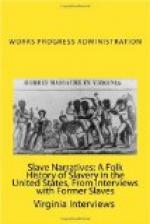Smith, John H.
Snow, Charlie and Maggie
Solomon, Robert
Spikes, James
Stanford, Kittie
Stanhouse, Tom
Starnes, Isom
Steel, Hezekiah (Ky)
Stenhouse, Maggie
Stephens, Charlotte E.
Stevens, William J.
Stewart, Minnie Johnson
Stiggers, Liza
Stith, James Henry
Stout, Caroline
Street, Felix
Tabon, Mary
Tanner, Liza Moore
Tatum, Fannie
Taylor, Anthony
Taylor, Lula
Taylor, Millie
Taylor, Sarah
Taylor, Warren
Teague, Sneed
Teel, Mary
Thermon, Wade
Thomas, Dicey
Thomas, Mandy
Thomas, Omelia
Thomas, Omelia
Thomas, Tanner
Thomas, Wester
Thompson, Annie [TR: Corrected from “Thomas”]
Thompson, Ellen Briggs
Thompson, Hattie
Thompson, Mamie
Thompson, Mike
Thornton, Laura
Tidwell, Emma (Bama?)
Tillman, Joe
Tims, J.T.
Travis, Hannah
Trotter, Mark C.
Tubbs, James
Tucker, Mandy
Turner, Emma
Turner, Henry
Tuttle, Seabe
Texarkana District
folklore subjects
Name of Interviewer: Cecil Copeland
Subject: Social Customs—Reminiscences
of an Ex-Slave
Subject: Foods
This Information given by: Doc Quinn
Place of Residence: 1217 Ash Street, Texarkana,
Arkansas
Occupation: None [TR: also reported as Ex-slave.]
Age: 93 [TR: also reported as 94.]
[TR: Information moved from bottom of first page.]
[TR: Repetitive information deleted from subsequent
pages.]
Several months ago, I called at 1217 Ash Street, Texarkana, Arkansas where I had been informed a voluble old negro lived. An aged, gray-haired, negro woman came to the door and informed me her father was in the wood shed at the back of the house. Going around to the wood shed I found him busily engaged in storing his winter supply of wood. When I made known my mission he readily agreed to answer all my questions as best he could. Seating himself on a block of wood, he told this almost incredible story, along with lengthy discourses on politics, religion and other current events:
“I wuz born March 15, 1843, in Monroe County, Mississippi, near Aberdeen, Mah Mahster wuz Colonel Ogburn, one ob de bigges’ planters in de state of Mississippi. Manys de time he raised so much cotton dat dem big steamers just couldnt carry it all down to N’Awlins in one year. But den along came de Civil War an’ we didn’t raise nothin’ fo’ several years. Why? Becase most uf us jined the Confederate Army in Colonel Ogburn’s regiment as servants and bodyguards. An’ let me tell yo’ somethin’, whitefolks. Dere never wuz a war like dis war. Why I ’member dat after de battle of Corinth, Miss., a five acre field was so thickly covered wid de dead and wounded dat yo’ couldn’t touch de ground in walkin’ across it. And de onliest way to bury dem wuz to cut a deep furrow wid a plow, lay de soldiers head to head, an’ plow de dirt back on dem.”




